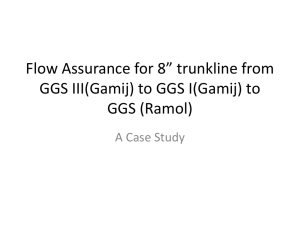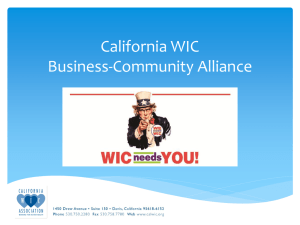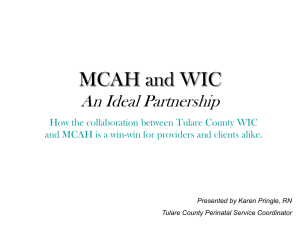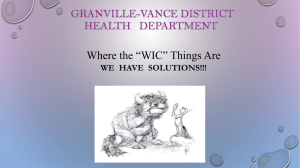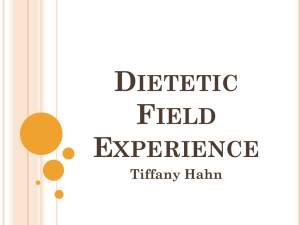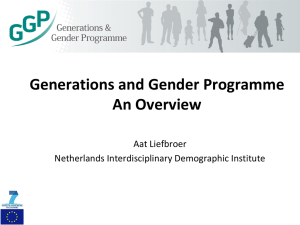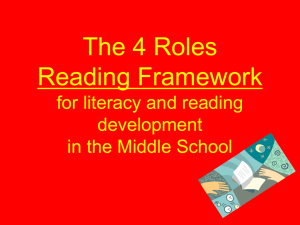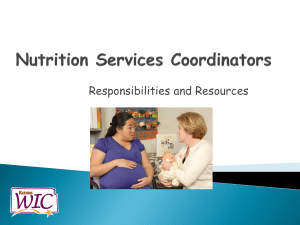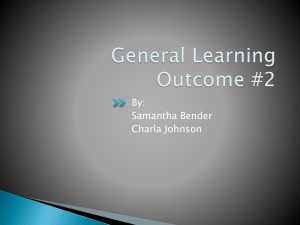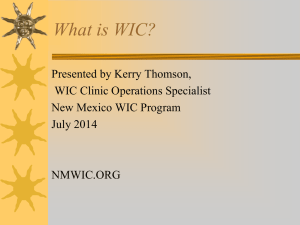Guided Goal Setting - Office of Family Health Services
advertisement
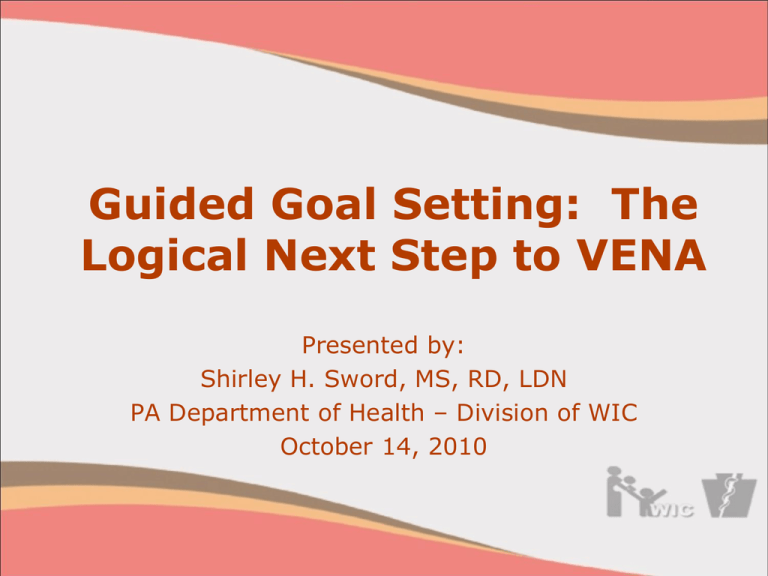
Guided Goal Setting: The Logical Next Step to VENA Presented by: Shirley H. Sword, MS, RD, LDN PA Department of Health – Division of WIC October 14, 2010 Objectives • To gain insight on the history of the development of Guided Goal Setting • To understand the research behind development of the Guided Goal Setting Module • To learn the local agency perspective on how Guided Goal Setting is working in the clinics Facts and Figures About PA • 9th Largest WIC Program • 44,817 square miles • 274 people per square mile • One-third of our 12.4 million residents live in rural areas, the largest non-urban population in the nation • 2nd highest percentage of residents >65 years old in the country Facts and Figures About PA WIC • 67 Counties • 24 Local Agencies – Community Action Programs – Medical Centers – County Health Departments – Private, Non-Profits • 265,000 Monthly Caseload Service Delivery System • 329 Total WIC Clinics – 116 Primary Sites – 213 Satellite Sites • Users in total - 832 – 383 CPAs – 449 Non-CPAs • 1767 WIC Authorized Stores • On-site, On-demand Check Printing How It All Got Started Special Project Grants • Special funding from USDA for special State projects of regional or national significance to improve the services of the program • Address issues of critical and timely importance • Requires a rigorous evaluation component • Results are widely disseminated to other States Our Special Project Grant Development and Evaluation of Guided Goal Setting (GGS) as a Behavior Change Approach and Monitoring Protocol in Pennsylvania WIC Partners in This Project • PA WIC – Shirley Hsi Sword, Project Director • Indiana U of PA – Stephanie Taylor-Davis, Principal Investigator – Mia M. Barker, Co-Investigator – William F. Barker, Evaluator – Pao Ying Hsiao, Research Assistant Goals of this Project • To enhance the quality of WIC services provided to PA WIC participants • To further VENA initiatives via an evaluated and measurable, participantcentered nutrition education counseling approach that: • Maintains continuity from visit to visit • Empowers participants • Benefits the participant The Basis for Goal Setting • Straight-forward behavioral change approach that accommodates a variety of achievement levels • Emphasizes small, progressive steps that are concrete • Relevant to address emerging preventionoriented public health concerns • Supported in scientific and behavioral literature with a variety of populations and topic areas Guided Goal Setting (GGS): Defined An approach used by the nutritionist in conjunction with the participant that involves critical thinking based on assessment to develop strategies for goal setting to achieve desired participant outcomes Central Mission • Identification, development, implementation, and evaluation of GGS as a WIC counseling method to: – Increase participant-centered approach – Enhance staff competency and critical thinking skills – Assess participant commitment to foodbased behavior change – Extend nutrition education by supplementing contact points with targeted reinforcements GGS: Special Project Grant Results by Year 2005-2008 Goals by Year • Year 1: “Profile Identification and WIC Evaluation” – Assess the state of being in PA WIC with respect to goal setting as a nutrition education counseling approach • Year 2: “Guided Goal Setting Practices & Assessment” – Formalize the GGS process through development and pilot testing of a training module and assessment tools • Year 3: “Improvement – Nutrition Education & Outcomes” – Project 1 = Provide standardized training to nutritionists to improve staff competency – Project 2 = Run an experimental protocol with GGS that uses reinforcement and is participant-centered and individualized Year 1 Projects 1. Interview and survey WIC staff to identify nutrition education best practices and barriers to best practices (n=147) 2. Survey WIC participants (not initially in proposal) (n=4665) Year 1: Data Collection • Demographic Survey • Written Surveys • Semi-structured interviews – Face-to-face – Telephone • • • • Nutrition Education Services Survey Director Survey Nutrition Education Coordinator Survey WIC Participant Survey Year 1: Research Study Participants Constituency State Agency Staff* n 5 Local Agency Directors 24 Nutrition Education Coordinators 18 CPAs/Nutritionists Participants (all local agencies represented) Average Years of Service in PA WIC (range) 14.5 years (2-24 years) 19 years (3-31.5 years) 9.5 years (<1-24 years) 100 8 years (<1-24.5 years) 4665 n/a Results: Year 1 – Staff Insights • Common themes for implementing: – Time – Environment – Distractions – Training – Resources – Attitudes about goal setting Results: Year 1 – Staff Insights • Best practices: – Participant-centered – Committed and knowledgeable staff – Receptive participants – Good assessment with critical thinking – Personalizing process – Establish expectation for goal setting Results: Year 1 – Staff Insights • Attributes: – Knowledge – Professional behaviors with participants – Professional behaviors within WIC – Program beliefs – Other – Professional values Results: Year 1: Participant Insights • Participant attitude different than staff perceptions • Liked best • • • • Helpful suggestions from nutritionist Caring Staff Handouts and brochures Recipes Results: Participant Insights (cont’d) Participant Response (n=4,665) Regarding What They Like About WIC Nutrition Information Helpful suggestions from nutritionist Caring Staff Handouts and Brochures Recipes Selected 1 response Selected more than 1 response 1050 (23%) 2909 (62%) 688 (15%) 2402 (52%) 478 (10%) 2158 (46%) 110 ( 2%) 890 (19%) Collective Voice: Year 1 Findings – – – – – TIME Staff issues Perceptions Participant issues Training issues – – – – Resources Sites Information Communication Year 2 Projects • Develop & test a standardized, yet flexible, theory-based, user-friendly training module and associated instrumentation that will strengthen staff skills and competencies to facilitate the GGS Process General Concept of GGS Module Development Literature Agency Staff LA Directors Nutrition Ed Coordinator Nutritionists GGS Module Units & Objectives GGS Practices Assessment Instruments Participants Theoretical Basis: GGS Framework Additional Year 1 Project Findings Incorporated • “Key principles, assumptions and expected components of a GGS contact” document • Recommendations regarding time and delivery system to support nutritionist and paraprofessional training • Best practices and success story reports from semi-structured interviews The GGS Module • • • • • Ten, 15 to 20-minute hands-on units Activity rich Case study oriented Learner workbook Evaluations: pre, one minute, post, workshop evaluation, and 6 week follow-up with “skill set use” • Pilot tested using facilitated group training GGS Module: Units 1-5 1. Definition and Relevance 2. Counseling Strategy for Behavior Change 3. Assessment and the Contribution of the WIC Staff 4. Personalizing the Process 5. Linking Risk Codes to Participant Goals GGS Module: Units 6-10 6. The Team Approach and Goal Priority 7. Structure of Measurable Goals 8. Documentation 9. Follow-Up and Goal Achievement 10. Action Plan Year 3 Projects 1.Staff Training using GGS module 2.Experimental protocol to test effectiveness of GGS with participants Year 3 Results: Staff Training • Alpha testing (February 2008) n=10 • Beta testing (July 2008) n=12 Pre- and post-training surveys One minute evaluations for each unit Overall workshop evaluation Six week follow-up “skill set use” survey GGS Training Evaluations GGS Evaluation: “Most Important Things Learned” α Site β Site How to set goal with more emphasis on client perspective Participant satisfaction is a goal we want to maintain; be more supportive to our participants Different approaches to clients Examples of dialogue with participants The importance of goal setting and the way you present yourself Allowing the participant to set goal Making the goals more specific, the who, action, number, etc. OK to brainstorm Effective communication for effective goal setting How to organize information I really enjoyed the concept maps Mapping To include the WIC participant when making goals How to make proper goals and documentation How to effectively and realistically develop customer based goals GGS Evaluation: “Least Important Things Learned” α Site Mapping Nutrition documentation example β Site Mapping Documentation Unit 1 and 2 GGS Evaluation: “How Use Information” α Site β Site Plan to use all aspects Share with team Documentation procedures Mapping to show problem areas visually Better understand staff’s job Daily counseling To bring together aspects of the visit Reinforcing positives Suggestions after Pilot Testing Based on α Site Based on β Site • Modified the units to make them more consistent in presentation style • Added a small amount of time to each unit • Most substantial revision was to Unit 6 – TEAM approach • Modified the way the documentation template was introduced in Unit 8 • Added the ‘Modified’ response option to Skill Set Survey Instrument • Spend more time on the last five units and less time on the overview • Split into two sessions • More examples of goals and documentation • Fewer evaluations or group them • Good information but could go at faster pace Conclusions after Pilot Testing • By establishing a baseline and a consistent structure for participant goal setting within PA WIC, there are now parameters upon which to evaluate the nutritionist-participant interaction and assess the efficacy of this counseling method to support participant behavior change. • The GGS Training Module and Assessment Instruments provide a mechanism to address staff (both CPA/Nutritionist and Other Staff) competency to facilitate the goal setting process with WIC participants. The Local Agency Perspective The Old Days The New Age - GGS Staff Reaction • Better working relationship with the clients • More open communication between staff and clients • More aware of the client’s perception of their family’s nutritional needs Client Reaction • “Your nutritionist was very well informed and offers great ideas and information.” • “Staff was very friendly and explained everything in detail and offered excellent help.” • “Staff made us feel comfortable with her advice and help.” • “The Staff spoke to me, not at me.” Hurdles to Cross • Don’t jump to conclusions! • Set small, achievable goals • Time • Documentation Effect on Clinic Operations • No change in staff duties • No operational changes within the clinic • Continuing education for professional and paraprofessional staff Our Results Number of Participants with a Goal Established Number of Participants with Follow-up Completed Number of Clients who achieved their Goal 360/360 323/353 218/323 100% 91.5% 67% Acknowledgements • USDA, Food and Nutrition Service • FNS Project Officers – Cherisa Toomer (May 2007 – December 2008) – Carol Stiller, MS, RD (September 2005 – April 2007) – Home Nursing Agency staff and participants – Adagio Health, Inc. • PA Department of Health, Bureau of Information Technology and Ciber, Inc. Contact Information Shirley H. Sword, MS, RD, LDN ssword@state.pa.us Stephanie Taylor-Davis, PhD, RD, LDN stdavis@iup.edu Mia Barker, PhD mabarker@iup.edu Tracy Kelley tkelley@homenursingagency.com
